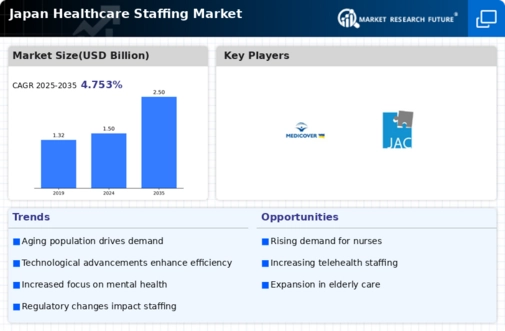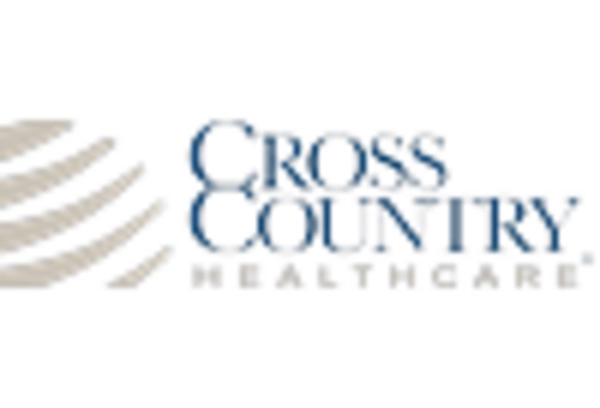Shift Towards Preventive Care
The shift towards preventive care in Japan is reshaping the healthcare staffing market. As healthcare providers increasingly focus on preventive measures to reduce long-term healthcare costs, there is a growing need for professionals who specialize in wellness and preventive services. This trend is likely to create new roles within healthcare organizations, such as health coaches and preventive care specialists, which were not as prevalent in the past. The emphasis on preventive care may lead to an estimated 10% increase in staffing requirements in this area by 2025. Consequently, healthcare facilities must adapt their staffing strategies to incorporate these new roles, thereby influencing the overall dynamics of the healthcare staffing market. This shift not only enhances patient outcomes but also necessitates a reevaluation of existing workforce capabilities to meet the evolving demands of the healthcare landscape.
Rising Healthcare Expenditures
The increasing healthcare expenditures in Japan serve as a significant driver for the healthcare staffing market. With healthcare spending projected to reach approximately ¥50 trillion by 2025, there is a corresponding need for a larger workforce to manage and deliver these services effectively. This financial commitment from both the government and private sectors indicates a robust investment in healthcare infrastructure, which inherently requires more personnel. As facilities expand and new services are introduced, the demand for healthcare professionals, including doctors, nurses, and allied health workers, is expected to rise. This trend suggests that the healthcare staffing market will need to adapt quickly to fill these roles, potentially leading to a competitive hiring landscape where organizations may need to enhance their recruitment strategies to attract talent.
Government Initiatives and Funding
Government initiatives aimed at improving healthcare services significantly impact the healthcare staffing market. In recent years, the Japanese government has increased funding for healthcare facilities, particularly in rural areas, to address disparities in access to care. This funding is often allocated to enhance staffing levels, thereby creating more job opportunities within the sector. For instance, the government has introduced subsidies for healthcare organizations that hire additional staff, which could lead to a projected growth of 15% in the healthcare workforce by 2025. Such initiatives not only bolster the staffing market but also ensure that healthcare facilities can maintain high standards of care. As a result, the healthcare staffing market is likely to experience a surge in demand for various roles, including administrative and clinical positions, as organizations strive to comply with government regulations and improve service delivery.
Aging Population and Healthcare Needs
The aging population in Japan is a critical driver for the healthcare staffing market. As the proportion of elderly individuals increases, the demand for healthcare services escalates. By 2025, it is projected that over 30% of the population will be aged 65 and older. This demographic shift necessitates a larger workforce to provide adequate care, particularly in geriatric services. Consequently, healthcare facilities are compelled to enhance their staffing levels to meet the growing needs of this demographic. The healthcare staffing market must adapt to these changes by recruiting more professionals, including nurses and caregivers who specialize in elder care. This trend indicates a potential increase in staffing costs, as facilities may need to offer competitive salaries to attract qualified personnel.
Technological Advancements in Healthcare
Technological advancements are profoundly influencing the healthcare staffing market. The integration of digital tools and telemedicine has transformed how healthcare services are delivered, necessitating a workforce that is adept at utilizing these technologies. As healthcare facilities adopt electronic health records (EHR) and telehealth platforms, there is a growing demand for staff who possess the necessary technical skills. This trend indicates that training and development will become increasingly important, as existing staff may require upskilling to keep pace with technological changes. By 2025, it is anticipated that the healthcare staffing market will see a 20% increase in demand for tech-savvy professionals, including IT specialists and data analysts, who can support these innovations. Thus, the healthcare staffing market must evolve to ensure that organizations can effectively leverage technology to enhance patient care and operational efficiency.

















Leave a Comment